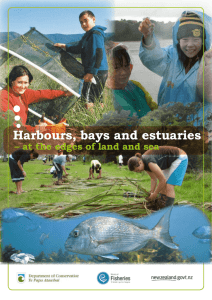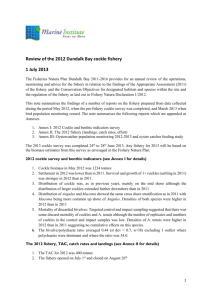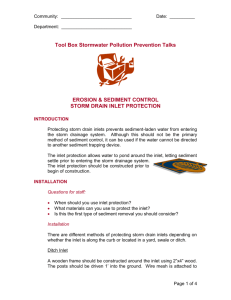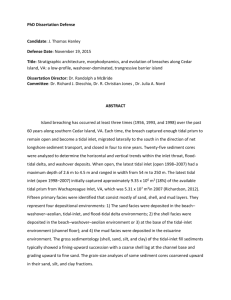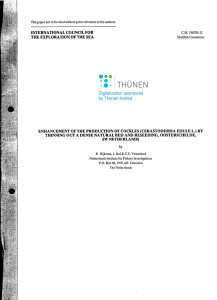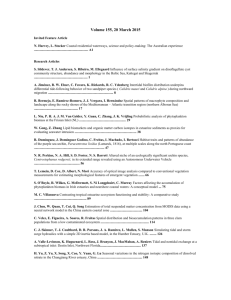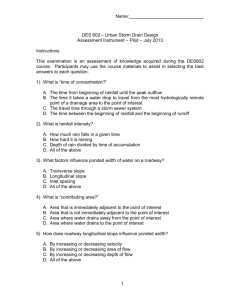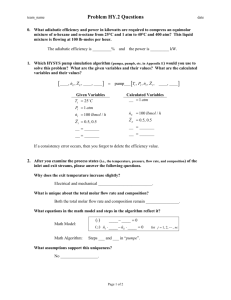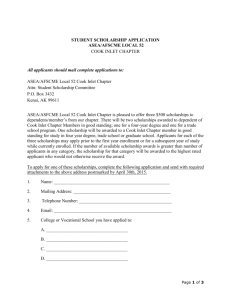Cockles - The Guardians of Pauatahanui Inlet
advertisement
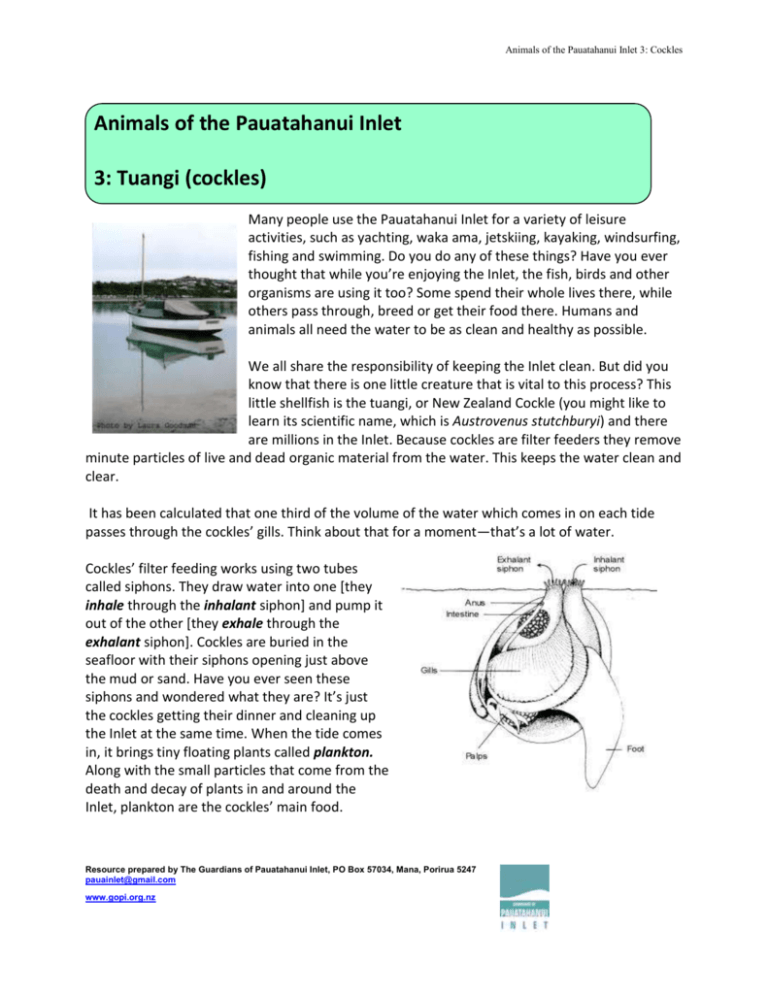
Animals of the Pauatahanui Inlet 3: Cockles Animals of the Pauatahanui Inlet 3: Tuangi (cockles) Many people use the Pauatahanui Inlet for a variety of leisure activities, such as yachting, waka ama, jetskiing, kayaking, windsurfing, fishing and swimming. Do you do any of these things? Have you ever thought that while you’re enjoying the Inlet, the fish, birds and other organisms are using it too? Some spend their whole lives there, while others pass through, breed or get their food there. Humans and animals all need the water to be as clean and healthy as possible. We all share the responsibility of keeping the Inlet clean. But did you know that there is one little creature that is vital to this process? This little shellfish is the tuangi, or New Zealand Cockle (you might like to learn its scientific name, which is Austrovenus stutchburyi) and there are millions in the Inlet. Because cockles are filter feeders they remove minute particles of live and dead organic material from the water. This keeps the water clean and clear. It has been calculated that one third of the volume of the water which comes in on each tide passes through the cockles’ gills. Think about that for a moment—that’s a lot of water. Cockles’ filter feeding works using two tubes called siphons. They draw water into one [they inhale through the inhalant siphon] and pump it out of the other [they exhale through the exhalant siphon]. Cockles are buried in the seafloor with their siphons opening just above the mud or sand. Have you ever seen these siphons and wondered what they are? It’s just the cockles getting their dinner and cleaning up the Inlet at the same time. When the tide comes in, it brings tiny floating plants called plankton. Along with the small particles that come from the death and decay of plants in and around the Inlet, plankton are the cockles’ main food. Resource prepared by The Guardians of Pauatahanui Inlet, PO Box 57034, Mana, Porirua 5247 pauainlet@gmail.com www.gopi.org.nz Animals of the Pauatahanui Inlet 3: Cockles The sea water also carries oxygen, and when the water is drawn in through the siphon the water passes over the cockle’s gills. The gills do two jobs—they take in oxygen and they filter out the tiny food particles. Tiny hairs wave the food over the gills and towards the large lips of the cockle’s mouth. Then the cockle pumps excess food, unsuitable particles and its body waste out through the exhaling siphon. What does a cockle look like? Cockles have two similar shells and are called bivalves (bi means two and valve means shell). You know how people say you can tell how old a tree is by counting its rings? That’s not exactly true, of course, but older trees do have more rings than younger trees. It’s much the same with cockles. The shells are ridged, and older cockles have more ridges than young cockles, so the number of ridges can indicate how old a cockle is. In the Inlet cockles can grow up to 60mm wide and can live for up to 20 years. As they grow the shell becomes sturdy and heavier and protects the cockle from physical damage. Where do they live? Cockles live just below the surface of the sea bottom in the fine sand and mud, and they survive best when the tide covers them for about 18 hours a day. They can’t survive if they are not covered for at least 3 hours a day, nor if the water is more than half fresh water. How does a cockle move? You will think this is quite complicated! The cockle moves using a foot which is like a little hollow tongue. When it burrows it pushes its foot hard into the sand and wiggles the tip of the foot backwards and forwards to make the hard sand softer. It then forces blood into the foot to make it swell at the tip. This forms an anchor. When it shortens the foot again the anchor holds firm and it is able to rock first the front and then the back of the shell down into the sand. At the same time it squirts little jets of water beside the shell so it is more easily pulled into the sand. Small cockles can also use this method to crawl over the surface of the sand. When you visit the Inlet you will be able to see the tracks that the cockles make when they move. Do cockles have enemies? They certainly do! Lots of creatures like to eat them, including humans, as you can see in the photo. Cockles live in a very shallow environment, so they are accessible to predators (this means it’s easy for predators to find them). They are a major food source for some fish and birds, and large numbers of young cockles are eaten by carnivorous snails. Humans are one of the main consumers of cockles. We know that the Maori who lived around the Inlet many years ago ate them, because the shells have been Resource prepared by The Guardians of Pauatahanui Inlet, PO Box 57034, Mana, Porirua 5247 pauainlet@gmail.com www.gopi.org.nz Animals of the Pauatahanui Inlet 3: Cockles found in some of the local middens (food rubbish dumps). It is interesting that some of these ancient shells are much larger than the shells that we find today. How do they reproduce? Cockles spawn from October to December. They release eggs and sperm into the water on an outgoing tide. The little larvae spend 3 to 6 weeks on the sea surface before settling on the bottom. Many young cockles are taken by predators in their first 3 years because their shells have not yet grown thick and heavy. How many cockles live in the Pauatahanui Inlet? Every three years the Guardians of the Pauatahanui Inlet survey the cockles to see if their numbers are decreasing or growing, and if they’re getting bigger, smaller, or staying the same. Perhaps your family has taken part in one of these surveys? In 1976 there were 520 million cockles in the Inlet but by 1992 there were only 220 million. The number of cockles has remained about the same since then. Why do you think cockle numbers might have dropped so dramatically between 1976 and 1992? Some activities for you 1 Create a quiz of 10 questions about the cockle that would be suitable for your class to answer. 2 Here is a list of some interesting words that have been used in the information about cockles. Use some of them in sentences to show that you understand the meanings. carnivorous, larvae, siphon, environment, filter, exhale, bivalve, plankton 3 A HAIKU poem is a special poem that only has three lines. The first line has five syllables, the second line has seven syllables, and the third line has five syllables. Write a haiku called COCKLES. When you only have 17 syllables to work with, every word must be an important word. Think about what you want to describe about this little shellfish. You might want to say what it looks like, how it moves, how it burrows to protect itself, how it feeds, or maybe why it is important. Acknowledgments. Photo of yacht: Laura Goodman, 2009 GOPI photo competition winner. Photo of the family eating cockles at Petone beach in 1979: Alexander Turnbull Library, Dominion Post Collection (PAColl-7327) Reference: EP/1979/0029-F, accessed at http://www.teara.govt.nz/en/seafood/3/6. Resource prepared by The Guardians of Pauatahanui Inlet, PO Box 57034, Mana, Porirua 5247 pauainlet@gmail.com www.gopi.org.nz
